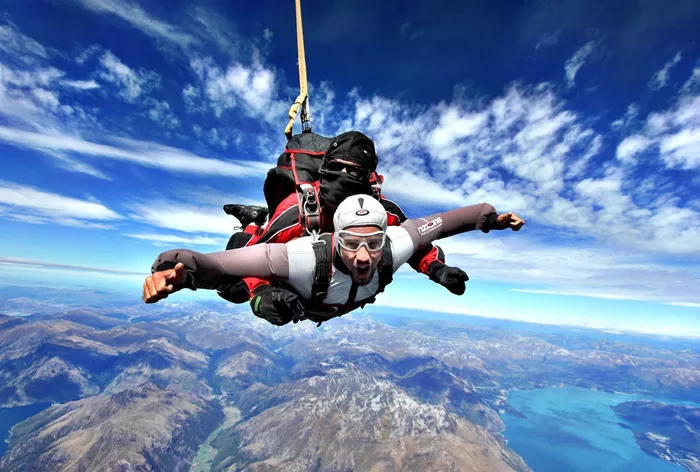Skydiving is an exhilarating sport that combines the thrill of freefall with the beauty of a bird’s-eye view of the earth. However, many newcomers and curious minds often wonder, “How hard is it to breathe while skydiving?” This article aims to answer that question comprehensively. We’ll explore the physiological aspects, the influence of altitude, the mechanics of breathing during freefall, and the experiences of seasoned skydivers.
Understanding the Physiology of Breathing
The Basics of Breathing
Breathing, or respiration, is a vital process that involves the inhalation of oxygen and the exhalation of carbon dioxide. This process is facilitated by the respiratory system, primarily the lungs, diaphragm, and chest muscles. Under normal conditions, the body efficiently regulates breathing without conscious effort.
The Impact of Altitude on Breathing
As altitude increases, the air pressure decreases, leading to a reduction in the density of oxygen molecules. This phenomenon, known as hypoxia, can make breathing more challenging. At high altitudes, such as those experienced during a skydive (typically between 10,000 and 15,000 feet), the body must work harder to obtain the necessary oxygen.
The Mechanics of Breathing During Freefall
Initial Exit: The Adrenaline Rush
The initial exit from the aircraft is often the most intense moment of a skydive. The sudden rush of wind and the rapid acceleration can momentarily disrupt normal breathing patterns. However, this effect is usually brief and subsides as the skydiver stabilizes their position.
Stabilizing in Freefall
Once in a stable freefall position, typically the belly-to-earth orientation, breathing becomes more manageable. The air rushing past the face can create a feeling of resistance, but it does not significantly hinder the ability to breathe. Skydivers often describe the sensation as akin to sticking their head out of a car window at high speed.
Terminal Velocity and Breathing
Terminal velocity, the constant speed a skydiver reaches when the forces of gravity and air resistance are balanced, is typically around 120 mph (193 km/h) for a belly-to-earth position. At this speed, the sensation of wind pressure is intense, but the body can still effectively manage breathing. The key is to stay relaxed and maintain a normal breathing pattern.
Common Concerns and Misconceptions
The Myth of Inability to Breathe
A common misconception is that the sheer speed and wind pressure during freefall make it impossible to breathe. This myth is unfounded. While the sensation is unusual and may require a brief adjustment period, the respiratory system is fully capable of functioning in freefall.
Hyperventilation and Skydiving
Hyperventilation, or rapid, shallow breathing, can occur if a skydiver is anxious or overly excited. This can lead to dizziness and a sensation of breathlessness. To prevent hyperventilation, it is crucial to practice controlled, deep breathing before and during the skydive.
Equipment and Breathing
Modern skydiving equipment, including helmets and jumpsuits, is designed to minimize discomfort and facilitate normal breathing. Open-faced helmets allow for unobstructed airflow, while full-faced helmets are equipped with ventilation systems to ensure a steady supply of air.
The Role of Training and Preparation
Pre-Jump Briefing
Before any skydive, a thorough pre-jump briefing is conducted. This briefing covers essential safety protocols, body positioning, and breathing techniques. Instructors emphasize the importance of staying calm and maintaining a regular breathing pattern.
Simulated Training
Many skydiving centers offer wind tunnel training, where participants can experience the sensation of freefall in a controlled environment. This training helps skydivers acclimate to the wind pressure and practice their breathing techniques.
Psychological Preparation
Mental preparation is a crucial aspect of skydiving. Techniques such as visualization and controlled breathing exercises can help reduce anxiety and improve overall performance during the jump.
Real-Life Experiences from Skydivers
Testimonials from Seasoned Skydivers
Experienced skydivers often share their personal experiences to reassure newcomers. Many highlight that while the initial moments of freefall can be intense, breathing becomes natural and manageable with practice.
Skydiver Stories
John, a seasoned skydiver with over 500 jumps, recalls his first experience: “I was so focused on the excitement and the view that I hardly noticed any difficulty breathing. The key is to stay relaxed and enjoy the moment.”
The Adaptation Process
Most skydivers find that after a few jumps, the sensation of breathing during freefall becomes second nature. The body adapts to the unique environment, and the initial concerns about breathing dissipate.
see also: Does Skydiving Through A Cloud Hurt?
The Influence of Physical Fitness on Breathing
The Importance of Physical Conditioning
Physical fitness plays a significant role in the ease of breathing during skydiving. A well-conditioned body is better equipped to handle the physical demands of freefall and the increased oxygen requirement at high altitudes.
Breathing Exercises for Skydivers
Incorporating specific breathing exercises into a regular fitness routine can enhance respiratory efficiency. Techniques such as diaphragmatic breathing and controlled breathing can improve lung capacity and oxygen utilization.
Conclusion: Embracing the Skydiving Experience
Skydiving is an extraordinary adventure that challenges both the body and mind. While the initial sensation of breathing during freefall may be unfamiliar, the human body is remarkably adaptable. With proper training, preparation, and a relaxed mindset, skydivers can enjoy the thrill of the jump without significant difficulty in breathing.
Whether you’re a first-time jumper or a seasoned skydiver, understanding the mechanics and techniques of breathing during freefall can enhance your overall experience. So take a deep breath, embrace the adrenaline, and savor the breathtaking journey from sky to earth.
related topics:
- Can Skydiving Help You Lose Weight?
- Why Do Skydiving Accidents Happen
- What It Takes To Skydive Solo?

